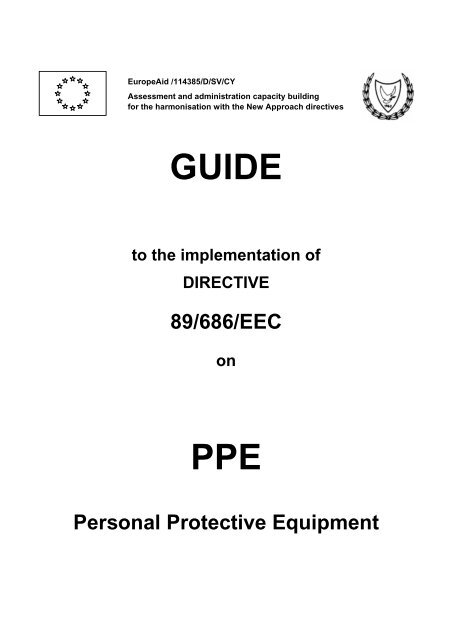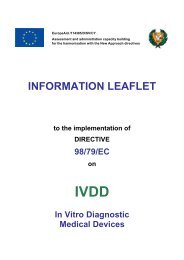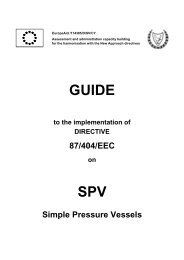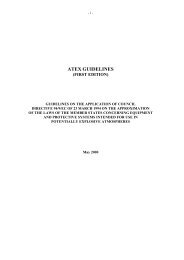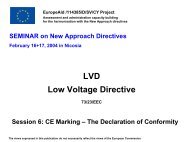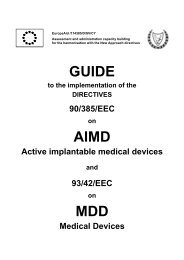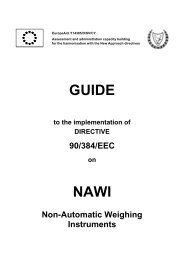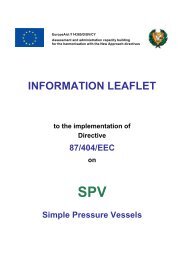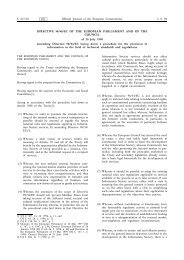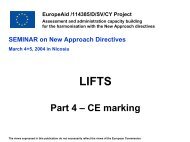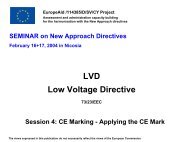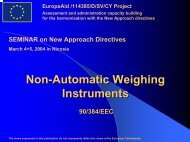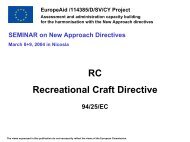GUIDE PPE - Cyprus Organization for the Promotion of Quality
GUIDE PPE - Cyprus Organization for the Promotion of Quality
GUIDE PPE - Cyprus Organization for the Promotion of Quality
You also want an ePaper? Increase the reach of your titles
YUMPU automatically turns print PDFs into web optimized ePapers that Google loves.
EuropeAid /114385/D/SV/CY<br />
Assessment and administration capacity building<br />
<strong>for</strong> <strong>the</strong> harmonisation with <strong>the</strong> New Approach directives<br />
<strong>GUIDE</strong><br />
to <strong>the</strong> implementation <strong>of</strong><br />
DIRECTIVE<br />
89/686/EEC<br />
on<br />
<strong>PPE</strong><br />
Personal Protective Equipment
Guide on <strong>PPE</strong> Directive<br />
EuropeAid /114385/D/SV/CY<br />
This Guide was printed with funds <strong>of</strong> <strong>the</strong> EuropeAid /114385/D/SV/CY project:<br />
“Assessment and administration capacity building <strong>for</strong> <strong>the</strong> harmonisation with <strong>the</strong> New Approach directives”<br />
The views expressed in this publication do not necessarily reflect <strong>the</strong> views <strong>of</strong> <strong>the</strong> European Commission,<br />
or <strong>the</strong> Ministry <strong>of</strong> Commerce, Industry and Tourism or <strong>the</strong> Ministry <strong>of</strong> Labour and Social Insurance.<br />
© Republic <strong>of</strong> <strong>Cyprus</strong>, Nicosia, May 2004
Guide on <strong>PPE</strong> Directive<br />
EuropeAid /114385/D/SV/CY<br />
INTRODUCTION<br />
This guide has been prepared in order to assist all parties involved in <strong>the</strong> application <strong>of</strong> Directive<br />
89/686/EEC on Personal Protective Equipment (<strong>PPE</strong>). The legally binding text is <strong>the</strong> directive itself and its<br />
implementation into <strong>the</strong> national legislation. Fur<strong>the</strong>r guidance has been given by <strong>the</strong> Working Group <strong>of</strong><br />
Committee 98/37/EC in relation to <strong>the</strong> Personal Protective Equipment (<strong>PPE</strong>) Directive 89/686/EEC.<br />
Any matter concerning <strong>the</strong> implementation or <strong>the</strong> practical application may be submitted to a Standing<br />
Committee. The committee is constituted by representatives <strong>of</strong> Member States, who are, <strong>for</strong> <strong>the</strong> most part,<br />
civil servants from Ministries <strong>of</strong> Labour or Industry, and presided by a representative <strong>of</strong> <strong>the</strong> European<br />
Commission.<br />
Representatives <strong>of</strong> o<strong>the</strong>r parties with an interest in <strong>the</strong> field <strong>of</strong> <strong>PPE</strong> are present with observer status.<br />
These include, in particular, manufacturers <strong>of</strong> <strong>PPE</strong> represented by European Safety Federation (ESF) and<br />
Federation <strong>of</strong> <strong>the</strong> European Sporting goods Industry (FESI), consumers represented by ANEC, <strong>the</strong> Trade<br />
Unions represented by TUTB, <strong>the</strong> Notified Bodies, represented by <strong>the</strong> Horizontal Co-ordination, and <strong>the</strong><br />
standardization organizations, represented by CEN.<br />
When a problem arising from interpretation or practical application <strong>of</strong> <strong>the</strong> directive is raised with <strong>the</strong><br />
Standing Committee, <strong>the</strong> Commission submits a proposed solution which is discussed by <strong>the</strong> Committee,<br />
and expresses its opinion, by a vote if need be. Each Member State may register its point <strong>of</strong> view. The<br />
Commission is required to take <strong>the</strong> utmost account <strong>of</strong> <strong>the</strong> opinion <strong>of</strong> <strong>the</strong> Standing Committee.<br />
Since <strong>the</strong> directive came into <strong>for</strong>ce, <strong>the</strong> Standing Committee and <strong>the</strong> Commission have developed a<br />
certain number <strong>of</strong> aids to interpreting and using <strong>the</strong> directive. These include a guide to <strong>the</strong> categorisation<br />
<strong>of</strong> <strong>PPE</strong> (in o<strong>the</strong>r words to <strong>the</strong> application <strong>of</strong> <strong>the</strong> different con<strong>for</strong>mity evaluation procedures to different<br />
kinds <strong>of</strong> <strong>PPE</strong>), and a list <strong>of</strong> “Questions and Answers” to problems posed by <strong>the</strong> application <strong>of</strong> <strong>the</strong> directive.<br />
These documents do not have legally binding <strong>for</strong>ce, but <strong>the</strong>y are useful tools <strong>for</strong> harmonising<br />
interpretation <strong>of</strong> <strong>the</strong> directive.<br />
In addition, <strong>the</strong> Standing Committee discusses and approves <strong>the</strong> Recommendation <strong>for</strong> Use sheets edited<br />
by <strong>the</strong> Horizontal Co-ordination <strong>of</strong> Notified Bodies, which provide a guide <strong>for</strong> <strong>the</strong> application <strong>of</strong> <strong>the</strong><br />
evaluation procedures by <strong>the</strong>se bodies.<br />
This document focuses specially on issues relevant to <strong>PPE</strong>. The documents and recommendations <strong>of</strong> <strong>the</strong><br />
Standing Committee and <strong>the</strong> co-ordination <strong>of</strong> <strong>the</strong> Notified Bodies are taken into account. General<br />
guidelines on <strong>the</strong> implementation <strong>of</strong> directives based on <strong>the</strong> New Approach and <strong>the</strong> Global Approach are<br />
given by <strong>the</strong> Commission (so called The Blue Guide). This guide can be found at:<br />
http://www.europa.eu.int/comm/enterprise/newapproach/legislation/guide/legislation.htm<br />
<strong>PPE</strong> DIRECTIVE 89/686/EEC<br />
Council Directive 89/686/EEC <strong>of</strong> 21 December 1989 on <strong>the</strong> approximation <strong>of</strong> <strong>the</strong> laws <strong>of</strong> <strong>the</strong> Member<br />
States relating to personal protective equipment has been amended three times.<br />
Amended by Council Directive 93/68/EEC; CE-marking<br />
Amended by Council Directive 93/95/EEC; transitional period extended to 30 June 1995 and helmets and<br />
visors intended <strong>for</strong> users <strong>of</strong> two- or three-wheeled motor vehicles were excluded from <strong>the</strong> scope.
Guide on <strong>PPE</strong> Directive<br />
EuropeAid /114385/D/SV/CY<br />
Amended by European Parliament and Council Directive 96/58/EC: The requirement to add last two digits<br />
<strong>of</strong> <strong>the</strong> year in which <strong>the</strong> CE marking was affixed was deleted.<br />
The directive will be amended and <strong>the</strong> latest working paper can be found at:<br />
http://www.europa.eu.int/comm/enterprise/mechan_equipment/ppe/index.htm<br />
The obligations created by <strong>the</strong> <strong>PPE</strong> Directive concern principally manufacturers <strong>of</strong> <strong>PPE</strong>. O<strong>the</strong>r agents,<br />
such as importers <strong>of</strong> <strong>PPE</strong> from third countries, wholesalers or distributors <strong>of</strong> <strong>PPE</strong>, may act as authorised<br />
representatives <strong>of</strong> <strong>PPE</strong> or take <strong>the</strong> responsibility <strong>the</strong>mselves <strong>for</strong> <strong>the</strong> placing <strong>of</strong> <strong>PPE</strong> on <strong>the</strong> market, but in<br />
that case <strong>the</strong>y assume all <strong>the</strong> duties <strong>of</strong> <strong>the</strong> manufacturer.<br />
Be<strong>for</strong>e production <strong>of</strong> a given model <strong>of</strong> <strong>PPE</strong>, <strong>the</strong> manufacturer must identify which <strong>of</strong> <strong>the</strong> Essential Health<br />
and Safety Requirements (EHSRs), detailed in Annex II <strong>of</strong> <strong>the</strong> directive, are applicable to <strong>the</strong> <strong>PPE</strong><br />
concerned. The <strong>PPE</strong> must be designed in such a way as to satisfy <strong>the</strong> relevant requirements.<br />
The manufacturer is free to choose <strong>the</strong> technical means <strong>of</strong> satisfying <strong>the</strong> requirements. He may choose to<br />
apply a harmonised standard, which both helps to identify <strong>the</strong> relevant requirements and provides a guide<br />
to <strong>the</strong> choice <strong>of</strong> technical solutions.<br />
The manufacturer must <strong>the</strong>n constitute <strong>the</strong> technical documentation, showing how <strong>the</strong> EHSRs have been<br />
satisfied. He must be able to produce relevant extracts <strong>of</strong> this documentation on request <strong>of</strong> <strong>the</strong> competent<br />
authorities.<br />
Be<strong>for</strong>e placing production <strong>of</strong> <strong>the</strong> model <strong>of</strong> <strong>PPE</strong> on <strong>the</strong> market, <strong>the</strong> manufacturer submits <strong>the</strong> model to <strong>the</strong><br />
appropriate con<strong>for</strong>mity evaluation procedure, which differs according to <strong>the</strong> risk covered by <strong>the</strong> equipment.<br />
He may <strong>the</strong>n affix <strong>the</strong> CE marking to <strong>the</strong> product and draw up <strong>the</strong> EC con<strong>for</strong>mity declaration.<br />
This declaration is an undertaking by <strong>the</strong> manufacturer as to <strong>the</strong> con<strong>for</strong>mity <strong>of</strong> each item <strong>of</strong> <strong>PPE</strong> actually<br />
placed on <strong>the</strong> market. It must be stressed that even when <strong>the</strong> con<strong>for</strong>mity evaluation procedure involves<br />
third-party examination <strong>of</strong> <strong>the</strong> model by a NB, <strong>the</strong> manufacturer remains entirely responsible <strong>for</strong> <strong>the</strong><br />
con<strong>for</strong>mity <strong>of</strong> <strong>the</strong> <strong>PPE</strong> actually produced and placed on <strong>the</strong> market.<br />
SCOPE, PLACING ON THE MARKET<br />
SCOPE OF THE DIRECTIVE<br />
The directive applies to <strong>PPE</strong>, which is defined as follows:<br />
For <strong>the</strong> purposes <strong>of</strong> this Directive, <strong>PPE</strong> shall mean any device or appliance designed to be worn or held<br />
by an individual <strong>for</strong> protection against one or more health and safety hazards.<br />
<strong>PPE</strong> shall also cover:<br />
(a) a unit constituted by several devices or appliances, which have been integrally combined by <strong>the</strong><br />
manufacturer <strong>for</strong> <strong>the</strong> protection <strong>of</strong> an individual against one or more potentially simultaneous risks. (Such<br />
as, <strong>for</strong> example an industrial safety helmet with hearing protectors and powered filtering device);<br />
(b) a protective device or appliance combined, separably or inseparably, with personal non-protective<br />
equipment worn or held by an individual <strong>for</strong> <strong>the</strong> execution <strong>of</strong> a specific activity; (such as <strong>for</strong> example<br />
industrial safety helmet equipped with a lamp)
Guide on <strong>PPE</strong> Directive<br />
EuropeAid /114385/D/SV/CY<br />
(c) interchangeable <strong>PPE</strong> components which are essential to its satisfactory functioning and used<br />
exclusively <strong>for</strong> such equipment. (Such as, <strong>for</strong> example components <strong>of</strong> fall arresting systems or<br />
replaceable filters <strong>for</strong> respiratory protective equipment)<br />
The term "worn" must be understood in <strong>the</strong> sense <strong>of</strong> wearing clo<strong>the</strong>s, a helmet, a mask, glasses, shoes,<br />
etc. The term "held" must be understood as <strong>the</strong> action <strong>of</strong> holding <strong>the</strong> <strong>PPE</strong> with one’s hand(s) (such as a<br />
hand-held protective screen used by welders to protect <strong>the</strong> face and eyes, <strong>for</strong> example). The <strong>PPE</strong><br />
Directive applies to all <strong>PPE</strong> <strong>for</strong> sport, domestic and leisure activities as well as <strong>for</strong> occupational use.<br />
The Directive does not apply to <strong>PPE</strong>s covered by ano<strong>the</strong>r directive designed to achieve <strong>the</strong> same<br />
objectives as <strong>PPE</strong> Directive with regard to placing on <strong>the</strong> market, free movement <strong>of</strong> goods and safety and<br />
to <strong>PPE</strong> listed in Annex I <strong>of</strong> <strong>the</strong> Directive:<br />
• <strong>PPE</strong> <strong>for</strong> <strong>the</strong> armed <strong>for</strong>ces or <strong>the</strong> maintenance <strong>of</strong> law and order;<br />
• <strong>PPE</strong> <strong>for</strong> self-defence;<br />
• <strong>PPE</strong> <strong>for</strong> private use against adverse atmospheric conditions, damp and water and heat;<br />
• <strong>PPE</strong> <strong>for</strong> <strong>the</strong> protection or rescue <strong>of</strong> persons on vessels or aircraft, not worn all <strong>the</strong> time;<br />
• Motorcycle helmets and visors.<br />
The guidance, how to apply <strong>the</strong> directive can be found at:<br />
http://www.europa.eu.int/comm/enterprise/mechan_equipment/ppe/guide.htm<br />
MANUFACTURER, PLACING ON THE MARKET AND BRINGING INTO SERVICE<br />
The <strong>PPE</strong> Directive aims at ensuring that <strong>PPE</strong> preserve <strong>the</strong> health and safety <strong>of</strong> users when <strong>the</strong>y are<br />
placed on <strong>the</strong> market and brought into service. Placing on <strong>the</strong> market corresponds to when <strong>the</strong> <strong>PPE</strong> is first<br />
made available, in return <strong>for</strong> payment or free <strong>of</strong> charge, by <strong>the</strong> manufacturer or his authorised<br />
representative in view <strong>of</strong> its distribution and/or its use in <strong>the</strong> EEA. Bringing into service includes all<br />
operations, which are necessary be<strong>for</strong>e <strong>the</strong> <strong>PPE</strong> is used by <strong>the</strong> end user. In practice, most <strong>PPE</strong> are<br />
placed on <strong>the</strong> market in a state where <strong>the</strong>y are ready <strong>for</strong> use. Recommendations how custom made (<strong>PPE</strong><br />
modified according to <strong>the</strong> characteristics <strong>of</strong> one specified user) <strong>PPE</strong> shall be placed on <strong>the</strong> market are<br />
given by <strong>the</strong> Standing Committee. The manufacturer is defined as follows;<br />
• any legal or natural person who takes responsibility <strong>for</strong> designing and manufacturing a <strong>PPE</strong> with a<br />
view to placing it on Community Market under his own name<br />
• any legal or natural person who assembles, packs, processes or re-label ready made products<br />
with a view to <strong>the</strong>ir being placed on Community Market under his own name<br />
• any legal or natural person who changes <strong>the</strong> intended use <strong>of</strong> product in such a way that different<br />
essential requirements will become applicable<br />
• any legal or natural person who customises, modifies or rebuilds a <strong>PPE</strong>
Guide on <strong>PPE</strong> Directive<br />
EuropeAid /114385/D/SV/CY<br />
CONFORMITY ASSESSMENT PROCEDURES<br />
THE THREE CATEGORIES OF <strong>PPE</strong><br />
In <strong>the</strong> Directive <strong>PPE</strong> is specifies in three different groups, according to <strong>the</strong> different con<strong>for</strong>mity<br />
assessment procedures. Normally <strong>the</strong>se groups are called categories. The categories correspond to<br />
different levels <strong>of</strong> <strong>the</strong> risk against which <strong>the</strong> <strong>PPE</strong> is designed to protect.<br />
Category Level <strong>of</strong> risk Con<strong>for</strong>mity assessment<br />
procedures<br />
I<br />
<strong>PPE</strong> models <strong>of</strong> simple design where <strong>the</strong> designer<br />
assumes <strong>the</strong> user can himself assess <strong>the</strong> level <strong>of</strong><br />
protection provided against <strong>the</strong> minimal risks<br />
concerned <strong>the</strong> effects <strong>of</strong> which can be safely<br />
identified by <strong>the</strong> user in good time.<br />
EC declaration <strong>of</strong> con<strong>for</strong>mity only.<br />
II<br />
All <strong>PPE</strong>, o<strong>the</strong>r than those in category I or in<br />
category III.<br />
EC type-examination and<br />
EC declaration <strong>of</strong> con<strong>for</strong>mity.<br />
III<br />
<strong>PPE</strong> <strong>of</strong> complex design intended to protect against<br />
mortal danger or against dangers that may<br />
seriously and irreversibly harm <strong>the</strong> health, <strong>the</strong><br />
immediate effects <strong>of</strong> which <strong>the</strong> designer assumes<br />
<strong>the</strong> user cannot identify in sufficient time.<br />
EC type-examination and ei<strong>the</strong>r -<br />
EC quality control system <strong>for</strong> <strong>the</strong><br />
final product, or -<strong>Quality</strong> control<br />
system <strong>for</strong> <strong>the</strong> production, and<br />
EC declaration <strong>of</strong> con<strong>for</strong>mity.<br />
Category I includes exclusively <strong>PPE</strong> intended to protect <strong>the</strong> wearer against:<br />
• mechanical action whose effects are superficial;<br />
• cleaning materials <strong>of</strong> weak action and easily reversible effects;<br />
• risks encountered in <strong>the</strong> handling <strong>of</strong> hot components which do not expose <strong>the</strong> user to a<br />
temperature exceeding 50 o C or to dangerous impacts;<br />
• atmospheric agents <strong>of</strong> a nei<strong>the</strong>r exceptional nor extreme nature;<br />
• minor impacts and vibrations which do not affect vital areas <strong>of</strong> <strong>the</strong> body and whose effects cannot<br />
cause irreversible lesions;<br />
• sunlight (sunglasses).<br />
Category III includes exclusively:<br />
• filtering respiratory devices <strong>for</strong> protection against solid and liquid aerosols or irritant, dangerous,<br />
toxic or radiotoxic gases;
Guide on <strong>PPE</strong> Directive<br />
EuropeAid /114385/D/SV/CY<br />
• respiratory protection devices providing full insulation from <strong>the</strong> atmosphere, including those <strong>for</strong><br />
use in diving;<br />
Category I Category II Category III<br />
Assemble technical documentation<br />
EC type-examination by a notified body<br />
'EC' quality<br />
control<br />
system <strong>for</strong><br />
<strong>the</strong> final<br />
product<br />
System <strong>for</strong><br />
ensuring EC<br />
quality <strong>of</strong><br />
production<br />
by means <strong>of</strong><br />
monitoring<br />
Draw up a declaration <strong>of</strong> con<strong>for</strong>mity<br />
Affix CE marking Affix CE marking Affix CE marking<br />
1234
Guide on <strong>PPE</strong> Directive<br />
EuropeAid /114385/D/SV/CY<br />
• <strong>PPE</strong> providing only limited protection against chemical attack or against ionising radiation;<br />
• emergency equipment <strong>for</strong> use in high-temperature environments, <strong>the</strong> effects <strong>of</strong> which are<br />
comparable to those <strong>of</strong> an air temperature <strong>of</strong> 100 °C or more and which may or may not be<br />
characterised by <strong>the</strong> presence <strong>of</strong> infrared radiation, flames or <strong>the</strong> projection <strong>of</strong> large amounts <strong>of</strong><br />
molten material;<br />
• emergency equipment <strong>for</strong> use in low-temperature environments <strong>the</strong> effects <strong>of</strong> which are<br />
comparable to those <strong>of</strong> an air temperature <strong>of</strong> - 50 °C or less;<br />
• <strong>PPE</strong> to protect against falls from a height;<br />
• <strong>PPE</strong> against electrical risks and dangerous voltages or used as insulation in high-tension work.<br />
All o<strong>the</strong>r <strong>PPE</strong> belong to category II. Thus no list <strong>of</strong> Category II <strong>PPE</strong> is given in <strong>the</strong> directive. The<br />
Commission has published a Guide to categorize <strong>PPE</strong>, which will be updated in <strong>the</strong> light <strong>of</strong> experience <strong>of</strong><br />
application <strong>of</strong> <strong>the</strong> directive.<br />
http://www.europa.eu.int/comm/enterprise/mechan_equipment/ppe/categorizationguide.pdf<br />
TECHNICAL DOCUMENTATION<br />
Be<strong>for</strong>e placing a <strong>PPE</strong> model on <strong>the</strong> market, <strong>the</strong> manufacturer must assemble a technical documentation<br />
<strong>the</strong> content <strong>of</strong> which is set out in Annex III <strong>of</strong> <strong>the</strong> directive. The documentation must comprise all relevant<br />
data on <strong>the</strong> means used by <strong>the</strong> manufacturer to ensure that a <strong>PPE</strong> complies with <strong>the</strong> EHSRs applicable.<br />
For category II and III <strong>PPE</strong>, <strong>the</strong> documentation must comprise in particular:<br />
1. The manufacturer’s technical file consisting <strong>of</strong>:<br />
• overall and detailed plans <strong>of</strong> <strong>the</strong> <strong>PPE</strong> accompanied, when appropriate, by calculation notes and<br />
<strong>the</strong> results <strong>of</strong> prototype tests in so far as necessary <strong>for</strong> <strong>the</strong> verification <strong>of</strong> compliance with <strong>the</strong><br />
EHSRs;<br />
• an exhaustive list <strong>of</strong> <strong>the</strong> EHSRs and <strong>of</strong> <strong>the</strong> harmonized standards or o<strong>the</strong>r technical specifications<br />
taken into account in <strong>the</strong> design <strong>of</strong> <strong>the</strong> model;<br />
2. A description <strong>of</strong> <strong>the</strong> control and test facilities to be used in <strong>the</strong> manufacturer's plant to check compliance<br />
<strong>of</strong> production <strong>PPE</strong> with <strong>the</strong> harmonized standards or o<strong>the</strong>r technical specifications and to maintain quality<br />
level;<br />
3. A copy <strong>of</strong> <strong>the</strong> in<strong>for</strong>mation supplied with <strong>the</strong> equipment shall be supplied to <strong>the</strong> notified body with <strong>the</strong><br />
technical file.
Guide on <strong>PPE</strong> Directive<br />
EuropeAid /114385/D/SV/CY<br />
NOTIFIED BODIES<br />
For most types <strong>of</strong> <strong>PPE</strong>, with <strong>the</strong> exception <strong>of</strong> a limited list <strong>of</strong> <strong>PPE</strong> to cover minimal risks, <strong>the</strong> directive<br />
requires third party con<strong>for</strong>mity evaluation prior to placing on <strong>the</strong> market. Some types <strong>of</strong> <strong>PPE</strong> <strong>for</strong> very<br />
serious risks are also submitted to evaluation <strong>of</strong> <strong>the</strong> con<strong>for</strong>mity <strong>of</strong> production. Member States are<br />
responsible <strong>for</strong> designating <strong>the</strong> bodies able to carry out <strong>the</strong>se evaluation procedures, and <strong>for</strong> notifying <strong>the</strong><br />
bodies thus approved to <strong>the</strong> European Commission. Annex V <strong>of</strong> <strong>the</strong> directive lays down <strong>the</strong> minimal<br />
criteria, which such a body must meet:<br />
• availability <strong>of</strong> <strong>the</strong> necessary personnel and equipment;<br />
• competence and integrity <strong>of</strong> personnel;<br />
• independence from parties with a vested interest in <strong>the</strong> manufacture and sale <strong>of</strong> <strong>PPE</strong>;<br />
• maintenance <strong>of</strong> pr<strong>of</strong>essional secrecy;<br />
• subscription to civil liability insurance.<br />
Bodies complying with <strong>the</strong> requirements <strong>of</strong> <strong>the</strong> appropriate standards <strong>of</strong> <strong>the</strong> EN ISO 17000 / EN 45000<br />
series are presumed to comply with <strong>the</strong>se minimum criteria. It is recommended that <strong>the</strong> testing<br />
laboratories should have accreditation according to <strong>the</strong> standard EN ISO 17025 Most Member States<br />
designate bodies, which have been accredited by <strong>the</strong> national accreditation system, according to one or<br />
o<strong>the</strong>r <strong>of</strong> <strong>the</strong>se standards.<br />
A body must be notified <strong>for</strong> one or more specific procedures: EC type-examination according to Article 10<br />
<strong>of</strong> <strong>the</strong> directive, or one <strong>of</strong> <strong>the</strong> EC quality control systems according to Article 11.<br />
Member States are free to take into account fur<strong>the</strong>r criteria, such as <strong>the</strong> particular experience <strong>of</strong> <strong>the</strong> body<br />
in <strong>the</strong> field <strong>of</strong> <strong>the</strong> <strong>PPE</strong> concerned, participation <strong>of</strong> <strong>the</strong> body in <strong>the</strong> work <strong>of</strong> co-ordination between Notified<br />
Bodies, or participation in standardization work.<br />
The notifying authority is also responsible <strong>for</strong> checking periodically that <strong>the</strong> bodies that <strong>the</strong>y have notified<br />
remain in compliance with <strong>the</strong> criteria. National authorities are free to choose <strong>the</strong> most effective and<br />
appropriate means <strong>of</strong> carrying out <strong>the</strong>se checks. Regular reporting on activity to <strong>the</strong> notifying authority<br />
seems indispensable. Some Member States delegate entirely <strong>the</strong> task <strong>of</strong> checking Notified Bodies to <strong>the</strong>ir<br />
national accreditation bodies. In o<strong>the</strong>r cases, <strong>the</strong> public authorities <strong>the</strong>mselves carry out regular audits <strong>of</strong><br />
<strong>the</strong> bodies <strong>the</strong>y have notified. In several Member States a combination <strong>of</strong> <strong>the</strong> two approaches is used.<br />
The list <strong>of</strong> Notified bodies is given in:<br />
http://www.europa.eu.int/comm/enterprise/mechan_equipment/ppe/nb.htm<br />
As NB fulfil tasks delegated to <strong>the</strong>m by public authorities, <strong>the</strong>y have a duty to take part in Co-ordination<br />
activities organised by <strong>the</strong> Commission. Objectives <strong>of</strong> <strong>the</strong> Co-ordination <strong>of</strong> Notified Bodies are as follows:<br />
• to share experience on practical application <strong>of</strong> <strong>the</strong> con<strong>for</strong>mity assessment procedures, with <strong>the</strong><br />
aim <strong>of</strong> reaching common understanding <strong>of</strong> <strong>the</strong> requirements <strong>of</strong> <strong>the</strong> directive;<br />
• to identify points <strong>of</strong> difficulty and propose agreed solutions on <strong>the</strong> basis <strong>of</strong> consensus;<br />
• to raise matters <strong>of</strong> interpretation <strong>of</strong> <strong>the</strong> directive with <strong>the</strong> Commission and Member States and<br />
seek guidance;
Guide on <strong>PPE</strong> Directive<br />
EuropeAid /114385/D/SV/CY<br />
• to discuss working documents submitted by <strong>the</strong> Commission and Member States and express <strong>the</strong><br />
views <strong>of</strong> Notified Bodies on <strong>the</strong> issues raised.<br />
The European Co-ordination <strong>of</strong> Notified Bodies <strong>for</strong> <strong>PPE</strong> has two basic structures: The Horizontal<br />
Committee <strong>of</strong> Notified Bodies <strong>for</strong> <strong>PPE</strong> deals with questions <strong>of</strong> general interest and Vertical Groups <strong>of</strong> NB<br />
<strong>for</strong> <strong>PPE</strong> are dealing with questions specific to certain <strong>PPE</strong> types The following Vertical Groups are in<br />
operation:<br />
VG 1<br />
VG 2<br />
VG 3<br />
VG 4<br />
VG 5<br />
VG 6<br />
VG 8<br />
VG 9<br />
VG 10<br />
VG 11<br />
Head protection<br />
Respiratory protection<br />
Eye and face protection<br />
Hearing protection<br />
Protective clothing, hand and arm protection<br />
Protection against knife cut<br />
Lifejackets<br />
Motorcycle rider's protective clothing and protectors <strong>for</strong> sports<br />
Foot and leg protection<br />
Protection against falls from a height<br />
In addition, an ad hoc Group <strong>of</strong> <strong>the</strong> Horizontal Group deals with questions arising from <strong>the</strong> quality control<br />
procedures defined by Articles 11 A and B <strong>of</strong> <strong>the</strong> directive.<br />
An important tool <strong>of</strong> <strong>the</strong> Co-ordination <strong>of</strong> Notified Bodies in <strong>the</strong> field <strong>of</strong> <strong>PPE</strong> is <strong>the</strong> drafting <strong>of</strong> Technical coordination<br />
sheets. If a NB, a Vertical group or <strong>the</strong> Horizontal Committee has a question <strong>of</strong> technical or<br />
horizontal nature, <strong>the</strong>y can draft a Proposal <strong>for</strong> Enquiry. This proposal contains a short description <strong>of</strong> <strong>the</strong><br />
problem and a proposed solution.<br />
If <strong>the</strong> question only concerns one Vertical Group, this group can approve <strong>the</strong> proposed solution and turn it<br />
into a Recommendation <strong>for</strong> Use, which is a recommendation <strong>for</strong> all <strong>the</strong> Notified Bodies, active in this field<br />
aiming at reaching uni<strong>for</strong>m treatment <strong>of</strong> <strong>the</strong> manufacturers throughout <strong>the</strong> Community. Most <strong>of</strong> <strong>the</strong><br />
recommendations <strong>of</strong> a vertical nature concern questions arising during <strong>the</strong> testing and certification<br />
process: ei<strong>the</strong>r no harmonized standards are available, or <strong>the</strong> harmonized standards are not sufficient or<br />
standards <strong>for</strong> test procedures are not precise enough. Recommendations <strong>for</strong> Use are thus in principle only<br />
temporary solution <strong>of</strong> problems arising from <strong>the</strong> use <strong>of</strong> standards. The aim must be to improve <strong>the</strong><br />
standards during <strong>the</strong> revision.<br />
If <strong>the</strong> question is <strong>of</strong> a horizontal nature or concerns interpretation <strong>of</strong> <strong>the</strong> directive, <strong>the</strong> Proposal <strong>for</strong> Enquiry<br />
is first dealt with by <strong>the</strong> Advisory Panel, <strong>the</strong>n transferred to <strong>the</strong> Horizontal Committee, where a decision is<br />
taken, ei<strong>the</strong>r to reject <strong>the</strong> proposal, or to pass on <strong>the</strong> enquiry to <strong>the</strong> Commission <strong>for</strong> discussion by <strong>the</strong><br />
Standing Committee. All Recommendations <strong>for</strong> Use <strong>of</strong> a horizontal nature are given to <strong>the</strong> Commission<br />
<strong>for</strong> in<strong>for</strong>mation, and those dealing with <strong>the</strong> interpretation <strong>of</strong> <strong>the</strong> <strong>PPE</strong> Directive, are submitted <strong>for</strong> approval
Guide on <strong>PPE</strong> Directive<br />
EuropeAid /114385/D/SV/CY<br />
to <strong>the</strong> Standing Committee. If <strong>the</strong> Recommendation <strong>for</strong> Use is <strong>of</strong> a general, horizontal nature, all Notified<br />
Bodies are in<strong>for</strong>med. If <strong>the</strong> Recommendation <strong>for</strong> Use is only <strong>of</strong> relevance <strong>for</strong> a certain area <strong>of</strong> <strong>PPE</strong>, only<br />
those Notified Bodies who are active in this field will be in<strong>for</strong>med.<br />
EC TYPE-EXAMINATION<br />
Prior to <strong>the</strong> (series) production <strong>of</strong> category II or III <strong>PPE</strong>, <strong>the</strong> manufacturer or his authorised representative<br />
established in <strong>the</strong> Community shall submit a model <strong>for</strong> EC type-examination. EC type-examination is <strong>the</strong><br />
procedure whereby a NB establishes and certifies that <strong>the</strong> <strong>PPE</strong> model in question satisfies <strong>the</strong> relevant<br />
provisions <strong>of</strong> <strong>the</strong> <strong>PPE</strong> Directive. Application <strong>for</strong> EC type-examination shall be made by <strong>the</strong> manufacturer<br />
or his authorised representative to a single approved inspection body in respect <strong>of</strong> <strong>the</strong> model in question.<br />
The application shall comprise:<br />
• The name and address <strong>of</strong> <strong>the</strong> manufacturer or his authorised representative and <strong>of</strong> <strong>the</strong> <strong>PPE</strong><br />
production plant in question;<br />
• The manufacturer's technical file;<br />
• The in<strong>for</strong>mation supplied by <strong>the</strong> manufacturer.<br />
It shall be accompanied by <strong>the</strong> appropriate number <strong>of</strong> specimens <strong>of</strong> <strong>the</strong> model to be approved. The<br />
number <strong>of</strong> samples needed determined by <strong>the</strong> NB, but indication is normally given in <strong>the</strong> relevant<br />
harmonized standard.<br />
The application <strong>of</strong> harmonized standards that give a presumption <strong>of</strong> con<strong>for</strong>mity remains voluntary. If <strong>the</strong><br />
manufacturer has designed <strong>the</strong> product according to a harmonized standard, <strong>the</strong> NB shall conduct <strong>the</strong> EC<br />
type-examination first examining <strong>the</strong> manufacturer's technical file to establish its suitability with respect to<br />
<strong>the</strong> harmonized standards.<br />
If a manufacturer has not applied, or has only partly applied, <strong>the</strong> harmonized standards, or when <strong>the</strong>re are<br />
no such standards, <strong>the</strong> NB must check <strong>the</strong> suitability <strong>of</strong> <strong>the</strong> technical specifications used by <strong>the</strong><br />
manufacturer with respect to <strong>the</strong> EHSRs. If <strong>the</strong> manufacturer partly applies a harmonized standard or if<br />
<strong>the</strong> relevant harmonized standard does not cover all <strong>the</strong> EHSRs applicable to <strong>the</strong> product, <strong>the</strong><br />
presumption <strong>of</strong> con<strong>for</strong>mity exists only with regard to <strong>the</strong> EHSRs covered by <strong>the</strong> standard.<br />
The NB shall make <strong>the</strong> necessary tests to verify that <strong>PPE</strong> has been produced in accordance with <strong>the</strong><br />
manufacturer's technical file and can be used in complete safety <strong>for</strong> its intended purpose in <strong>for</strong>eseeable<br />
conditions <strong>of</strong> use. Most <strong>PPE</strong> is tested according to <strong>the</strong> methods described in <strong>the</strong> harmonized standards.<br />
EC TYPE-EXAMINATION CERTIFICATE<br />
If <strong>the</strong> model satisfies <strong>the</strong> relevant requirements, <strong>the</strong> NB shall draw up an EC type-examination certificate.<br />
This certificate shall reproduce <strong>the</strong> findings <strong>of</strong> <strong>the</strong> examination, indicate any conditions attaching to its<br />
issue and incorporate <strong>the</strong> descriptions and drawings necessary <strong>for</strong> <strong>the</strong> identification <strong>of</strong> <strong>the</strong> approved<br />
model.<br />
If <strong>the</strong> <strong>PPE</strong> does not fulfil, <strong>the</strong> requirements <strong>of</strong> <strong>the</strong> directive, <strong>the</strong> NB shall refuse to issue an EC typeexamination<br />
certificate. In this case, <strong>the</strong> NB shall in<strong>for</strong>m <strong>the</strong> o<strong>the</strong>r Notified Bodies. However in practice <strong>the</strong><br />
testing is usually discontinued when negative results are found, and <strong>the</strong> manufacturer has <strong>the</strong> possibility<br />
to make changes to <strong>the</strong> design <strong>of</strong> <strong>the</strong> <strong>PPE</strong>.
Guide on <strong>PPE</strong> Directive<br />
EuropeAid /114385/D/SV/CY<br />
The NB shall withdraw <strong>the</strong> certificate if, <strong>for</strong> example, during <strong>the</strong> controls according to Article 11 <strong>the</strong> NB<br />
notices that <strong>the</strong> <strong>PPE</strong> is not in con<strong>for</strong>mity with <strong>the</strong> type described in <strong>the</strong> EC type-approval certificate. In<br />
such a case <strong>the</strong> NB shall in<strong>for</strong>m <strong>the</strong> Member State which shall <strong>the</strong>n in<strong>for</strong>m <strong>the</strong> o<strong>the</strong>r Member States and<br />
<strong>the</strong> Commission, setting out <strong>the</strong> reasons <strong>for</strong> <strong>the</strong> decision.<br />
EC QUALITY CONTROL SYSTEM FOR THE FINAL PRODUCT<br />
For category III products <strong>the</strong> manufacturer shall ei<strong>the</strong>r take <strong>the</strong> necessary steps to control <strong>the</strong> quality <strong>of</strong><br />
<strong>the</strong> final product (Article 11A) or he must have a quality-control system <strong>for</strong> <strong>the</strong> production (Article 11B).<br />
The manufacturer shall plan procedures to ensure that <strong>the</strong> manufacturing process, including <strong>the</strong> final<br />
inspection <strong>of</strong> <strong>PPE</strong> and tests, ensures <strong>the</strong> homogeneity <strong>of</strong> production and <strong>the</strong> con<strong>for</strong>mity <strong>of</strong> <strong>PPE</strong> with <strong>the</strong><br />
type described in <strong>the</strong> EC type-approval certificate and with <strong>the</strong> relevant EHSRs <strong>of</strong> <strong>the</strong> directive.<br />
The manufacturer selects a NB to carry out <strong>the</strong> necessary checks <strong>of</strong> <strong>the</strong> products. Those checks are<br />
carried out at random, normally at intervals <strong>of</strong> less than one year. Some Recommendation <strong>for</strong> Use sheets<br />
produced by <strong>the</strong> Co-ordination <strong>of</strong> Notified Bodies describe which tests are relevant <strong>for</strong> <strong>the</strong> checking <strong>of</strong> <strong>the</strong><br />
products. The NB gives <strong>the</strong> manufacturer a test report. The manufacturer must be able to present this<br />
report on request. The NB must try to find out <strong>the</strong> reasons if <strong>the</strong> checks reveal that <strong>the</strong> product does not<br />
fulfil <strong>the</strong> requirements or is not such as described in <strong>the</strong> technical file. It shall also in<strong>for</strong>m <strong>the</strong> Member<br />
State in such cases.<br />
SYSTEM FOR ENSURING EC QUALITY OF PRODUCTION BY MEANS OF MONITORING<br />
The manufacturer must make an application to <strong>the</strong> NB <strong>for</strong> <strong>the</strong> approval <strong>of</strong> his quality-control system. The<br />
application shall include:<br />
• all <strong>the</strong> in<strong>for</strong>mation relating to <strong>the</strong> category <strong>of</strong> <strong>PPE</strong> concerned, including, when appropriate,<br />
documentation relating to <strong>the</strong> approved model;<br />
• documentation on <strong>the</strong> quality-control system;<br />
• <strong>the</strong> undertaking to maintain <strong>the</strong> obligations arising from <strong>the</strong> quality-control system and to maintain<br />
its adequacy and efficiency.<br />
The directive requires that under this system, each model <strong>of</strong> <strong>PPE</strong> shall be examined and <strong>the</strong> appropriate<br />
tests specifically relating to <strong>the</strong> certification <strong>of</strong> <strong>PPE</strong> category III shall be carried out to check <strong>the</strong>ir<br />
con<strong>for</strong>mity to <strong>the</strong> relevant EHSRs <strong>of</strong> <strong>the</strong> directive. The documentation on <strong>the</strong> quality-control system shall<br />
in particular include an adequate description <strong>of</strong>:<br />
• <strong>the</strong> quality objectives, <strong>the</strong> organization chart, <strong>the</strong> responsibilities <strong>of</strong> executives and <strong>the</strong>ir powers in<br />
respect <strong>of</strong> product quality;<br />
• <strong>the</strong> checks and tests which must be carried out after manufacture;<br />
• <strong>the</strong> means to be employed to check <strong>the</strong> efficient operation <strong>of</strong> <strong>the</strong> quality-control system.<br />
The NB shall <strong>the</strong>n assess <strong>the</strong> quality-control system to determine whe<strong>the</strong>r it satisfies <strong>the</strong> requirements. A<br />
quality-control system satisfying <strong>the</strong> relevant harmonized standard is deemed to be in compliance with<br />
<strong>the</strong>se requirements. The <strong>PPE</strong> Directive does not refer any particular EN ISO 9000 standard when giving<br />
requirements to <strong>the</strong> quality control system <strong>for</strong> <strong>the</strong> production <strong>of</strong> <strong>PPE</strong>. The guidance given by <strong>the</strong><br />
Commission is that a system fulfilling <strong>the</strong> requirements given by EN ISO 9002 is deemed to fulfil <strong>the</strong>
Guide on <strong>PPE</strong> Directive<br />
EuropeAid /114385/D/SV/CY<br />
requirements <strong>of</strong> <strong>the</strong> directive. The requirements given in EN ISO 9003 shall be completed with some<br />
additional requirements. This guidance is not amended after <strong>the</strong> publication <strong>of</strong> <strong>the</strong> new EN ISO<br />
9001:2000. The European <strong>for</strong>eword <strong>of</strong> <strong>the</strong> standard gives some guidance and <strong>the</strong>re is also a<br />
Recommendation <strong>for</strong> Use sheet (Sheet number 119), describing, which clauses <strong>of</strong> <strong>the</strong> standard EN ISO<br />
9001:2000 are relevant.<br />
http://www.europa.eu.int/comm/enterprise/mechan_equipment/ppe/clarificationsheets/<br />
tablecontents.pdf<br />
The NB carries out audits to evaluate <strong>the</strong> quality-control system and to make sure that <strong>the</strong> manufacturer is<br />
maintaining and applying <strong>the</strong> approved quality control.<br />
THE EC DECLARATION OF CONFORMITY<br />
The manufacturer or his authorised representative must draw up and sign an EC declaration <strong>of</strong> con<strong>for</strong>mity<br />
<strong>for</strong> each model <strong>of</strong> <strong>PPE</strong> whatever its category. In this declaration <strong>the</strong> manufacturer certifies that <strong>the</strong> <strong>PPE</strong><br />
placed on <strong>the</strong> market is in con<strong>for</strong>mity with <strong>the</strong> provisions <strong>of</strong> <strong>the</strong> <strong>PPE</strong> Directive. The declaration also<br />
contains reference to <strong>the</strong> harmonized standards applied, to <strong>the</strong> EC type-examination certificate and to <strong>the</strong><br />
NB responsible <strong>for</strong> <strong>the</strong> 11 A or B procedure, as appropriate. A model <strong>of</strong> this declaration is given in Annex<br />
VI <strong>of</strong> <strong>the</strong> directive.<br />
CE MARKING<br />
The CE marking shall be affixed to each item <strong>of</strong> <strong>PPE</strong> placed on <strong>the</strong> market and on its packaging. If<br />
marking on <strong>the</strong> <strong>PPE</strong> is impossible (<strong>for</strong> instance, because it is too small) <strong>the</strong> marking may be on <strong>the</strong><br />
packaging only. The marking must be visible, legible and indelible throughout <strong>the</strong> <strong>for</strong>eseeable useful life<br />
<strong>of</strong> <strong>the</strong> <strong>PPE</strong>. O<strong>the</strong>r marks, which could be confused with <strong>the</strong> CE marking, may not be affixed to <strong>PPE</strong>.<br />
CE marking is evidence that <strong>the</strong> product con<strong>for</strong>ms to all <strong>the</strong> relevant EHSRs and that <strong>the</strong> product has<br />
been subject to <strong>the</strong> appropriate con<strong>for</strong>mity assessment procedure. The <strong>for</strong>m <strong>of</strong> CE marking is given in<br />
Annex IV <strong>of</strong> <strong>the</strong> directive (which has been amended twice, by Directive 93/68/EEC [10] and Directive<br />
96/58/EC). [13] It must have a minimum height <strong>of</strong> 5 mm except <strong>for</strong> very small <strong>PPE</strong>.<br />
For category I equipment <strong>the</strong> CE marking is <strong>the</strong> letters CE in <strong>the</strong> given <strong>for</strong>m. The same goes <strong>for</strong> category<br />
II products, which can be identified as Category II products from <strong>the</strong> in<strong>for</strong>mation notice supplied by <strong>the</strong><br />
manufacturer, which must include <strong>the</strong> name and address <strong>of</strong> <strong>the</strong> NB having made <strong>the</strong> EC typeexamination.<br />
For category III products, <strong>the</strong> CE marking includes <strong>the</strong> identification number <strong>of</strong> <strong>the</strong> NB<br />
responsible <strong>for</strong> <strong>the</strong> Article 11 A or 11 B procedure.
Guide on <strong>PPE</strong> Directive<br />
EuropeAid /114385/D/SV/CY<br />
ESSENTIAL HEALTH AND SAFETY REQUIREMENTS (EHSRS)<br />
GENERAL<br />
The basic health and safety requirements are normally called as Essential Health and Safety<br />
Requirements. The EHRSs are set out in annex II <strong>of</strong> <strong>the</strong> Directive 89/686/EEC. Annex II is divided into<br />
three sections<br />
• General requirements applicable to all <strong>PPE</strong>;<br />
• Additional requirements common to several classes or types <strong>of</strong> <strong>PPE</strong>;<br />
• Additional requirements specific to particular risks.<br />
GENERAL REQUIREMENTS<br />
The basic principle laid down by Annex II is that <strong>PPE</strong> should provide <strong>the</strong> highest level <strong>of</strong> protection<br />
possible. The optimum level <strong>of</strong> protection to be taken into account in <strong>the</strong> design is that beyond which <strong>the</strong><br />
constraints imposed by <strong>the</strong> wearing <strong>of</strong> <strong>the</strong> <strong>PPE</strong> would prevent its effective use during <strong>the</strong> period <strong>of</strong><br />
exposure to <strong>the</strong> risk or normal per<strong>for</strong>mance <strong>of</strong> <strong>the</strong> activity.<br />
The first section <strong>of</strong> Annex II also includes requirements concerning levels <strong>of</strong> risk, <strong>the</strong> innocuousness <strong>of</strong><br />
<strong>PPE</strong>, com<strong>for</strong>t and efficiency and <strong>the</strong> in<strong>for</strong>mation to be supplied by <strong>the</strong> manufacturer.<br />
ADDITIONAL REQUIREMENTS COMMON TO SEVERAL CLASSES OR TYPES OF <strong>PPE</strong><br />
The second section <strong>of</strong> Annex II includes requirements <strong>for</strong> <strong>PPE</strong>:<br />
• incorporating adjustment systems;<br />
• <strong>for</strong> <strong>the</strong> face, eyes and respiratory tracts;<br />
• subject to ageing;<br />
• which may be caught up during use;<br />
• <strong>for</strong> use in explosive atmospheres;<br />
• <strong>for</strong> emergencies, requiring rapid donning or removal;<br />
• <strong>for</strong> use in very dangerous situations;<br />
• incorporating components which can be adjusted or removed by <strong>the</strong> user;<br />
• <strong>for</strong> connection to ano<strong>the</strong>r, external complementary device;<br />
• incorporating a fluid circulation system;<br />
• bearing identification or recognition marks;<br />
• <strong>for</strong> signalling <strong>the</strong> user's presence visually;<br />
• and multi-risk <strong>PPE</strong>.
Guide on <strong>PPE</strong> Directive<br />
EuropeAid /114385/D/SV/CY<br />
ADDITIONAL REQUIREMENTS SPECIFIC TO PARTICULAR RISKS<br />
The third section <strong>of</strong> Annex II includes requirements relevant to <strong>PPE</strong> designed to protect against:<br />
• mechanical impact, falls due to slipping, falls from a height and vibration;<br />
• compression, abrasion, per<strong>for</strong>ation, cuts and bites;<br />
• drowning;<br />
• noise, heat and fire, and cold;<br />
• electric shock, non-ionising and ionising radiation;<br />
• dangerous substances and infectious agents: respiratory protection and cutaneaous and ocular<br />
contact;<br />
• risks incurred during diving.
Guide on <strong>PPE</strong> Directive<br />
EuropeAid /114385/D/SV/CY<br />
HARMONISED STANDARDS<br />
GENERAL<br />
Harmonized standards are European standards:<br />
• prepared in accordance with <strong>the</strong> General Guidelines agreed between <strong>the</strong> European Commission<br />
and CEN / CENELEC;<br />
• mandated by <strong>the</strong> Commission;<br />
• adopted in accordance with CEN/CENELEC rules, <strong>of</strong>ficially presented to <strong>the</strong> Commission<br />
following <strong>the</strong>ir adoption.<br />
Harmonized standards provide a presumption <strong>of</strong> con<strong>for</strong>mity with EHSRs if <strong>the</strong>y are published at <strong>the</strong><br />
national level in at least one Member State and <strong>the</strong>ir references are published in <strong>the</strong> OJEC.<br />
There are seven specific <strong>PPE</strong> standardisation Technical Committees in CEN<br />
TC number Field Subgroups Secretariat<br />
CEN / TC 79 Respiratory protective devices 9 SC DIN (Germany)<br />
CEN / TC 85 Eye-protective equipment 9 WG AFNOR (France)<br />
CEN / TC 158 Head protection 11 WG BSI (U-K)<br />
CEN / TC 159 Hearing protectors 3 WG SIS (Sweden)<br />
CEN / TC 160<br />
Protection against falls from a height and work<br />
restraint systems<br />
5 WG DIN (Germany)<br />
CEN / TC 161 Foot and leg protectors 4 WG BSI (U-K)<br />
CEN / TC 162<br />
Protective clothing including hand and arm<br />
protection and lifejackets<br />
12 WG DIN (Germany)<br />
OTHER TCS DEALING WITH <strong>PPE</strong> ARE:<br />
TC number Field Secretariat<br />
CEN/TC 122/JWG 9 Ergonomics <strong>of</strong> <strong>PPE</strong> DS (Denmark)<br />
CEN/TC 136 WG 5,6,7<br />
Sports-Playground and o<strong>the</strong>r recreational<br />
equipment<br />
DIN (Germany)<br />
CENELEC/TC 78 Equipment and tools <strong>for</strong> live working UTE (France)
Guide on <strong>PPE</strong> Directive<br />
EuropeAid /114385/D/SV/CY<br />
CEN/TC 211 Acoustics DS (Denmark)<br />
CEN/TC 231/WG 3 Vibrations DIN (Germany)<br />
More than 300 harmonised standards are already published and many <strong>of</strong> those are under revision. Lists <strong>of</strong><br />
<strong>PPE</strong> harmonised standards have been published by <strong>the</strong> OJEC under <strong>the</strong> following references:<br />
Commission communication in relation to personal protective equipment - OJ C 203 <strong>of</strong> 28.8.2003. The list<br />
<strong>of</strong> <strong>the</strong> harmonised standards can be found also at:<br />
http://europa.eu.int/comm/enterprise/newapproach/standardization/harmstds/reflist/ppe.html<br />
INTERNATIONAL STANDARDISATION<br />
In order to avoid <strong>the</strong> barriers to international trade, it has been accepted to give preference to <strong>the</strong><br />
international standardisation. Some ISO technical committees (like ISO TC 94/SC13, ISO TC 94/SC 14<br />
and ISO TC 94/SC 15) are already drafting new standards.<br />
CYPRUS STANDARDS BODY<br />
Fur<strong>the</strong>r in<strong>for</strong>mation on standards and guidance in<strong>for</strong>mation can be obtained from <strong>the</strong> Standards Body <strong>of</strong><br />
<strong>Cyprus</strong>:<br />
CYS<br />
<strong>Cyprus</strong> Organisation <strong>for</strong> <strong>the</strong> <strong>Promotion</strong> <strong>of</strong> <strong>Quality</strong><br />
At <strong>the</strong> Ministry <strong>of</strong> Commerce, Industry and Tourism<br />
13-15, Andreas Araouzos Street<br />
1421 Nicosia<br />
RELATION WITH OTHER DIRECTIVES<br />
GENERAL<br />
If different aspects <strong>of</strong> a product are dealt with by more than one directive, it may only be placed on <strong>the</strong><br />
market and/or put into service when it complies with <strong>the</strong> requirements and <strong>the</strong> con<strong>for</strong>mity assessment<br />
procedures <strong>of</strong> all <strong>the</strong> directives applicable to it.<br />
THE MEDICAL DEVICES DIRECTIVE (93/42/EEC)<br />
This directive applies to devices, o<strong>the</strong>r than medicines, used in health care. It aims at protecting <strong>the</strong><br />
health and safety <strong>of</strong> patients and users <strong>of</strong> medical devices, and o<strong>the</strong>r exposed persons. The directive<br />
states in Article 1.6 that it is not applicable to <strong>PPE</strong>. The decision as to which directive is applicable<br />
depends on <strong>the</strong> principal use <strong>of</strong> <strong>the</strong> device. Thus surgical masks used principally to protect <strong>the</strong> patient are
Guide on <strong>PPE</strong> Directive<br />
EuropeAid /114385/D/SV/CY<br />
under <strong>the</strong> medical devices directive. However equipment worn by health care personnel to protect<br />
<strong>the</strong>mselves against infectious agents is under <strong>the</strong> <strong>PPE</strong> Directive.<br />
Corrective spectacles are medical devices, but protective spectacles with corrective lenses are under <strong>PPE</strong><br />
Directive because <strong>the</strong>ir main aim is to protect <strong>the</strong> eyes <strong>of</strong> <strong>the</strong> wearer. (The additional optical correction<br />
increases <strong>the</strong> com<strong>for</strong>t and usability <strong>of</strong> <strong>the</strong> <strong>PPE</strong> because <strong>the</strong> worker does not have to wear simultaneously<br />
corrective lenses).<br />
Some <strong>PPE</strong> are adapted to <strong>the</strong> individual user's needs, such as orthopaedic shoes or individually moulded<br />
earplugs. In <strong>the</strong>se cases <strong>the</strong> <strong>PPE</strong> Directive is applicable.<br />
THE MARINE EQUIPMENT DIRECTIVE (96/98/EC)<br />
This Directive covers equipment used on board sea-going ships. The Directive does not prescribe CE<br />
marking, as it establishes a special con<strong>for</strong>mity marking (a Steering Wheel); however <strong>the</strong> principles are<br />
identical to those concerning CE marking. Ra<strong>the</strong>r than essential requirements, equipment covered by <strong>the</strong><br />
directive must meet <strong>the</strong> applicable requirements <strong>of</strong> <strong>the</strong> international conventions, <strong>the</strong> relevant resolutions<br />
and circulars <strong>of</strong> <strong>the</strong> IMO, and <strong>the</strong> relevant international testing standards.<br />
The <strong>PPE</strong> used on board and listed in this directive, shall fulfil <strong>the</strong> requirements <strong>of</strong> marine directive only.<br />
For <strong>the</strong> <strong>PPE</strong> <strong>the</strong> directive requires EC type-examination and production quality assurance (module D), or<br />
product quality assurance (module E) or product verification (module F).<br />
Annex A1 <strong>of</strong> <strong>the</strong> Directive contains a list <strong>of</strong> equipment <strong>for</strong> which detailed testing standards already exist in<br />
international regulations. In this list, lifejackets, immersion suits and <strong>the</strong>rmal protective aids are<br />
mentioned. In Annex 2 <strong>of</strong> <strong>the</strong> directive, <strong>the</strong>re is a list stating equipment <strong>for</strong> which no international test<br />
standards exist. This list includes firemen's breathing apparatus. These annexes will be amended<br />
periodically and relevant references to EN ISO standards will be added. The testing <strong>for</strong> CE marking or<br />
Steering Wheel marking will be similar, so equipment concerned will be marked under one or <strong>the</strong> o<strong>the</strong>r<br />
directive, depending on its intended use.<br />
THE TOYS DIRECTIVE (88/378/EEC)<br />
This directive covers safety <strong>of</strong> products designed <strong>for</strong> play <strong>for</strong> children under 14.<br />
Equipment designed to be worn by children (such as bicycle or ski helmets, ski goggles etc.) to protect<br />
<strong>the</strong>m against a risk comes under <strong>the</strong> <strong>PPE</strong> Directive.<br />
However children also play with imitations <strong>of</strong> adult <strong>PPE</strong> (such as imitations <strong>of</strong> firemen's helmets, nurse's<br />
protective clothing etc). Such imitated <strong>PPE</strong> <strong>for</strong> children comes under <strong>the</strong> Toys Directive and according to<br />
<strong>the</strong> Annex <strong>of</strong> this directive manufacturers <strong>of</strong> such toys must supply a warning to avoid any confusion with<br />
real <strong>PPE</strong>.<br />
THE MACHINERY DIRECTIVE (98/37/EC)<br />
This directive applies to machinery, and is based on <strong>the</strong> principle <strong>of</strong> integration <strong>of</strong> measures by design to<br />
ensure <strong>the</strong> safety <strong>of</strong> users. In <strong>the</strong> design <strong>of</strong> control devices, constraints due to <strong>the</strong> necessary or<br />
<strong>for</strong>eseeable use <strong>of</strong> personal protection equipment (such as footwear, gloves, etc.) must be taken into<br />
account.
Guide on <strong>PPE</strong> Directive<br />
EuropeAid /114385/D/SV/CY<br />
According to <strong>the</strong> directive, <strong>the</strong> manufacturer <strong>of</strong> <strong>the</strong> machine shall in<strong>for</strong>m users <strong>of</strong> <strong>the</strong> residual risks due to<br />
any shortcomings <strong>of</strong> <strong>the</strong> protection measures adopted, indicate whe<strong>the</strong>r any particular training is required<br />
and specify any need to provide personal protective equipment.<br />
THE GENERAL PRODUCT SAFETY DIRECTIVE (2001/95/EC)<br />
The General Product Safety Directive is aimed at ensuring that consumer products placed on <strong>the</strong> EU<br />
market are safe. The objectives <strong>of</strong> <strong>the</strong> Directive are both to protect consumer health and safety and to<br />
ensure <strong>the</strong> proper functioning <strong>of</strong> <strong>the</strong> internal market. The Directive applies to products intended <strong>for</strong> or<br />
likely to be used by consumers. It obliges producers to place only “safe” products on <strong>the</strong> market. When<br />
<strong>the</strong> manufacturer is not based in <strong>the</strong> EU, this obligation applies to his representative in <strong>the</strong> EU or, in <strong>the</strong><br />
absence <strong>of</strong> a representative, to <strong>the</strong> importer.<br />
The GPSD is intended to ensure a high level <strong>of</strong> product safety throughout <strong>the</strong> EU <strong>for</strong> consumer products<br />
not covered by sector legislation, but also to complete and complement <strong>the</strong> provisions <strong>of</strong> such sector<br />
legislation <strong>for</strong> <strong>the</strong> risks, <strong>the</strong> producer obligations and <strong>the</strong> authorities’ powers and tasks not covered in it.<br />
The Directive provides a generic definition <strong>of</strong> safe product. Products in con<strong>for</strong>mity with <strong>the</strong> specific rules<br />
(like <strong>PPE</strong> directive) applicable in <strong>the</strong> Member State in which <strong>the</strong>y are in circulation are deemed to meet<br />
<strong>the</strong> definition <strong>of</strong> safe product. In <strong>the</strong> absence <strong>of</strong> specific national rules, <strong>the</strong> safety <strong>of</strong> a product shall be<br />
assessed having regard to European standards, Community technical specifications, national standards <strong>of</strong><br />
<strong>the</strong> country in which <strong>the</strong> product is in circulation, codes <strong>of</strong> good practice, <strong>the</strong> state <strong>of</strong> <strong>the</strong> art and<br />
expectations <strong>of</strong> consumers.<br />
In addition to <strong>the</strong> basic requirement to place only safe products on <strong>the</strong> market, producers must in<strong>for</strong>m<br />
consumers <strong>of</strong> <strong>the</strong> risks associated with <strong>the</strong> products <strong>the</strong>y supply. They must take measures to be in<strong>for</strong>med<br />
<strong>of</strong> risks posed by <strong>the</strong> products which <strong>the</strong>y supply and take <strong>the</strong> appropriate measures to prevent such risks.<br />
Finally, <strong>the</strong>y must be able to trace dangerous products.<br />
The <strong>PPE</strong> Directive does not contain any system <strong>for</strong> rapid exchange <strong>of</strong> in<strong>for</strong>mation between market<br />
surveillance authorities in emergency situations. There<strong>for</strong>e, <strong>the</strong> provisions concerning <strong>the</strong> procedure <strong>for</strong><br />
rapid exchange <strong>of</strong> in<strong>for</strong>mation on dangers and <strong>the</strong> subsequent action at Community level are applicable to<br />
<strong>PPE</strong> <strong>for</strong> consumer use.<br />
DIRECTIVE CONCERNING THE MINIMUM HEALTH AND SAFETY REQUIREMENTS FOR<br />
THE USE OF PERSONAL PROTECTIVE EQUIPMENT BY WORKERS AT WORKPLACE<br />
(89/656/EEC)<br />
On <strong>the</strong> basis <strong>of</strong> <strong>the</strong> Article 16 <strong>of</strong> <strong>the</strong> Framework Directive (89/391/EEC), directive concerning <strong>the</strong> minimum<br />
health and safety requirements <strong>for</strong> <strong>the</strong> use <strong>of</strong> personal protective equipment by workers at workplace has<br />
been given. The general principle <strong>of</strong> <strong>the</strong> directive is that <strong>PPE</strong> shall be used when <strong>the</strong> risks cannot be<br />
avoided or sufficiently limited by technical means, by collective protective measures, or by methods <strong>of</strong><br />
work organization.<br />
The assessment <strong>of</strong> <strong>the</strong> needs to use <strong>PPE</strong> has three phases:<br />
• an analysis and assessment <strong>of</strong> risks which cannot be avoided by o<strong>the</strong>r means;<br />
• based on this risk assessment, <strong>the</strong> characteristics <strong>of</strong> <strong>the</strong> <strong>PPE</strong> needed must be defined;
Guide on <strong>PPE</strong> Directive<br />
EuropeAid /114385/D/SV/CY<br />
• <strong>the</strong> <strong>PPE</strong> must <strong>the</strong>n be selected among CE marked <strong>PPE</strong>, taking <strong>the</strong> special needs <strong>of</strong> <strong>the</strong> workplace<br />
and worker into account.<br />
This assessment must be reviewed, if any changes occur.<br />
The employer must ensure, that <strong>the</strong> <strong>PPE</strong>:<br />
• complies with <strong>the</strong> requirements <strong>of</strong> <strong>the</strong> <strong>PPE</strong> Design Directive 89/686/CEE;<br />
• is appropriate <strong>for</strong> <strong>the</strong> risks involved, without itself leading to any increased risks;<br />
• corresponds to existing conditions at <strong>the</strong> workplace;<br />
• is selected taking ergonomic requirements and <strong>the</strong> worker’s state <strong>of</strong> health into account;<br />
• fits <strong>the</strong> wearer correctly after any necessary adjustment;<br />
• is compatible with o<strong>the</strong>r items <strong>of</strong> <strong>PPE</strong> worn simultaneously;<br />
• is in principle <strong>for</strong> personal use;<br />
• is provided free <strong>of</strong> charge;<br />
• is kept in good working order by means <strong>of</strong> necessary maintenance.<br />
Also <strong>the</strong> conditions <strong>of</strong> use shall be determined. These include <strong>the</strong> determination <strong>of</strong> <strong>the</strong> length <strong>of</strong> <strong>the</strong> use<br />
period, taking into account <strong>the</strong> seriousness <strong>of</strong> <strong>the</strong> risk, frequency <strong>of</strong> exposure, <strong>the</strong> characteristics <strong>of</strong> <strong>the</strong><br />
workstation <strong>of</strong> each worker and <strong>the</strong> per<strong>for</strong>mance <strong>of</strong> <strong>the</strong> <strong>PPE</strong>. The employer shall in<strong>for</strong>m <strong>the</strong> workers <strong>of</strong><br />
<strong>the</strong> risks and arrange <strong>the</strong> necessary training.<br />
THE PRODUCT LIABILITY DIRECTIVE (85/374/EEC)<br />
This Directive deals with liability <strong>for</strong> any product manufactured or imported into <strong>the</strong> Community, which<br />
causes damage to individuals or property. It thus may apply to damage caused by defective <strong>PPE</strong>. The<br />
objective <strong>of</strong> <strong>the</strong> <strong>PPE</strong> Directive is to prevent, as far as possible, <strong>the</strong> placing on <strong>the</strong> market and putting into<br />
service <strong>of</strong> unsafe <strong>PPE</strong>. The Product Liability Directive is a fur<strong>the</strong>r incitement to <strong>the</strong> manufacturer to design<br />
and make safe products, in light <strong>of</strong> <strong>the</strong> costs incurred through liability <strong>for</strong> defective products. Thus <strong>the</strong> <strong>PPE</strong><br />
Directive and <strong>the</strong> Product Liability Directive may be seen as complementary.<br />
OTHER DIRECTIVES<br />
O<strong>the</strong>r directive, which may be applicable to <strong>PPE</strong>, is ATEX directive concerning equipment intended to be<br />
used in potentially explosive atmospheres. Some equipment, like e.g. powered respiratory protective<br />
equipment, shall be assessed also against requirements <strong>of</strong> <strong>the</strong> ATEX directive.<br />
Some <strong>PPE</strong> may contain pressure vessels. Those are covered by Directive 87/404/EEC, as amended.
Guide on <strong>PPE</strong> Directive<br />
EuropeAid /114385/D/SV/CY<br />
MARKET SURVEILLANCE<br />
The <strong>PPE</strong> Directive defines <strong>the</strong> responsibility <strong>of</strong> Member States <strong>for</strong> market surveillance in very general<br />
terms:<br />
“Member States shall take all appropriate measures to ensure that <strong>PPE</strong> ... may be placed on<br />
<strong>the</strong> market and brought into service only if it preserves <strong>the</strong> health and ensures <strong>the</strong> safety <strong>of</strong><br />
users ... when properly maintained and used <strong>for</strong> its intended purpose.” (Article 2.1. <strong>of</strong> <strong>the</strong><br />
directive).<br />
Member States must allow free circulation to <strong>PPE</strong> placed on <strong>the</strong> market in compliance with <strong>the</strong><br />
requirements <strong>of</strong> <strong>the</strong> directive. But <strong>the</strong> presumption <strong>of</strong> compliance accorded to “CE” marked products is<br />
not absolute: it is subordinated to <strong>the</strong> duty to protect <strong>the</strong> health and safety <strong>of</strong> users.<br />
“ If a Member State discovers that <strong>PPE</strong> bearing CE marking and used in accordance with its<br />
intended purpose could compromise <strong>the</strong> safety <strong>of</strong> individuals, domestic animals or property, it shall<br />
take all necessary measures to remove that equipment from <strong>the</strong> market and prohibit <strong>the</strong> marketing<br />
or free movement <strong>the</strong>re<strong>of</strong> (Article 7.1. <strong>of</strong> <strong>the</strong> directive).<br />
The responsibility <strong>of</strong> Member States to thus ensure that only safe products are placed on <strong>the</strong> market<br />
implies <strong>the</strong> obligation to organise and carry out effective surveillance <strong>of</strong> <strong>the</strong> market. The main aim <strong>of</strong> this<br />
surveillance is to ensure that <strong>the</strong> EHSRs <strong>of</strong> <strong>the</strong> directive are satisfied by <strong>the</strong> <strong>PPE</strong> effectively placed on <strong>the</strong><br />
market.<br />
In <strong>the</strong> case <strong>of</strong> <strong>PPE</strong> certified by <strong>the</strong> manufacturer himself, market surveillance is necessary to ensure that<br />
this simple procedure is not seen as an open door <strong>for</strong> noncompliant products.<br />
In <strong>the</strong> case <strong>of</strong> <strong>the</strong> majority <strong>of</strong> <strong>PPE</strong>, <strong>for</strong> which <strong>the</strong> model has been approved by a third party be<strong>for</strong>e<br />
production is placed on <strong>the</strong> market, market surveillance involves checking that <strong>the</strong> products effectively<br />
placed on <strong>the</strong> market are in con<strong>for</strong>mity with <strong>the</strong> provisions <strong>of</strong> <strong>the</strong> <strong>PPE</strong> directive. It may also bring to light<br />
cases where con<strong>for</strong>mity evaluation has not been properly carried out by <strong>the</strong> NB.<br />
For <strong>PPE</strong> submitted to <strong>the</strong> procedures described in Article 11 <strong>of</strong> <strong>the</strong> directive, involving approval <strong>of</strong> <strong>the</strong><br />
manufacturers’ quality-control system or periodic controls <strong>of</strong> production, market surveillance may be<br />
considered less vital. But experience shows, even in this case, that checks are useful to ensure that <strong>the</strong><br />
procedures are being properly applied.<br />
Market surveillance is thus an essential tool <strong>for</strong> effective en<strong>for</strong>cement <strong>of</strong> <strong>the</strong> provisions <strong>of</strong> <strong>the</strong> directive. It<br />
is to be considered vital to <strong>the</strong> credibility <strong>of</strong> CE marking, and more generally, to creating confidence in <strong>the</strong><br />
single market.<br />
WHO IS RESPONSIBLE FOR MARKET SURVEILLANCE?<br />
Market surveillance must be carried out with a guaranty <strong>of</strong> impartiality and objectivity, which implies<br />
overall responsibility by <strong>the</strong> public authorities <strong>of</strong> Member States. In particular, surveillance <strong>of</strong> <strong>PPE</strong> already
Guide on <strong>PPE</strong> Directive<br />
EuropeAid /114385/D/SV/CY<br />
placed on <strong>the</strong> market is not <strong>the</strong> job <strong>of</strong> <strong>the</strong> Notified Bodies responsible <strong>for</strong> evaluation <strong>of</strong> <strong>PPE</strong> models be<strong>for</strong>e<br />
<strong>the</strong>y are placed on <strong>the</strong> market.<br />
However <strong>the</strong> public authorities do not always have <strong>the</strong> necessary expertise or equipment needed to carry<br />
out <strong>the</strong> very specific tests required to check <strong>the</strong> con<strong>for</strong>mity <strong>of</strong> <strong>PPE</strong> with EHSRs. The public authorities may<br />
thus call on competent bodies, including <strong>the</strong> Notified Bodies, to provide this expertise, while remaining<br />
sole judge <strong>of</strong> <strong>the</strong> conclusions to be drawn and <strong>the</strong> action to be taken.<br />
Member States must designate <strong>the</strong> authorities responsible <strong>for</strong> en<strong>for</strong>cement, including market surveillance<br />
<strong>of</strong> <strong>PPE</strong>. They may be national, regional or local authorities, provided <strong>the</strong> whole national territory is<br />
covered. Market surveillance may also be shared between several authorities; indeed this may be<br />
necessary to cover both <strong>PPE</strong> <strong>for</strong> pr<strong>of</strong>essional and private use <strong>for</strong> which distribution channels are <strong>of</strong>ten<br />
different.<br />
The authorities concerned may include <strong>the</strong> consumer protection services, labour inspection, and customs<br />
authorities. When Member States designate several authorities <strong>for</strong> market surveillance it is necessary to<br />
organise co-ordination <strong>of</strong> <strong>the</strong>ir activity. It is also useful to select a single co-ordinating authority, which may<br />
be <strong>the</strong> correspondent <strong>for</strong> <strong>the</strong> authorities <strong>of</strong> o<strong>the</strong>r Member States.<br />
These authorities must have <strong>the</strong> necessary powers and be attributed sufficient resources to be able to<br />
carry out effective market surveillance activity. These include <strong>the</strong> power to visit manufacturers’ distributors’<br />
or users’ premises, to take or purchase samples <strong>for</strong> examination or <strong>for</strong> testing, and to require all<br />
necessary in<strong>for</strong>mation.<br />
Market surveillance activity can take several <strong>for</strong>ms. Schematically, it is possible to distinguish <strong>for</strong>mal<br />
checks from checks on substantial, technical compliance with EHSRs.<br />
CHECKS ON MARKING AND DOCUMENTATION<br />
The directive provides <strong>the</strong> authorities responsible <strong>for</strong> market surveillance with a number <strong>of</strong> tools <strong>for</strong><br />
checking compliance with <strong>the</strong> con<strong>for</strong>mity evaluation procedures.<br />
Absence <strong>of</strong> CE marking is a clear indication that <strong>the</strong> requirements <strong>of</strong> <strong>the</strong> directive have not been taken<br />
into account.<br />
The manufacturers’ EC declaration <strong>of</strong> con<strong>for</strong>mity must be produced on demand. This document enables<br />
market surveillance authorities to know which evaluation procedure has been followed, <strong>the</strong> notified body<br />
or bodies concerned, and <strong>the</strong> harmonized standard or standards used.<br />
The in<strong>for</strong>mation contained in <strong>the</strong> EC declaration <strong>of</strong> con<strong>for</strong>mity can be compared with <strong>the</strong> manufacturers’<br />
instructions <strong>for</strong> use (which must accompany <strong>the</strong> <strong>PPE</strong>), to check that <strong>the</strong> evaluation procedure followed<br />
corresponds to <strong>the</strong> risks against which <strong>the</strong> <strong>PPE</strong> is designed to protect.<br />
The in<strong>for</strong>mation contained in <strong>the</strong> EC declaration <strong>of</strong> con<strong>for</strong>mity also enables <strong>the</strong> authorities to contact <strong>the</strong><br />
Notified Bodies concerned in order to obtain a copy <strong>of</strong> <strong>the</strong> EC type-examination certificate, <strong>of</strong> <strong>the</strong><br />
manufacturers’ technical file and <strong>of</strong> <strong>the</strong> test reports.<br />
Finally, <strong>the</strong> authorities may require <strong>the</strong> manufacturer to produce relevant extracts <strong>of</strong> <strong>the</strong> technical<br />
documentation in support <strong>of</strong> <strong>the</strong> EC con<strong>for</strong>mity declaration.<br />
In many cases, examination <strong>of</strong> <strong>the</strong> marking and documentation may be considered a sufficient indication<br />
<strong>of</strong> <strong>the</strong> con<strong>for</strong>mity <strong>of</strong> <strong>the</strong> <strong>PPE</strong>. However, in case <strong>of</strong> doubt as to <strong>the</strong> con<strong>for</strong>mity <strong>of</strong> <strong>PPE</strong> with <strong>the</strong> EHSRs or
Guide on <strong>PPE</strong> Directive<br />
EuropeAid /114385/D/SV/CY<br />
with <strong>the</strong> per<strong>for</strong>mance levels claimed by <strong>the</strong> manufacturer, it is generally not possible to reach a conclusion<br />
simply by visual examination. Checking technical con<strong>for</strong>mity <strong>of</strong> <strong>PPE</strong> requires carrying out laboratory tests.<br />
CHECKING COMPLIANCE WITH ESSENTIAL HEALTH AND SAFETY REQUIREMENTS<br />
The tests necessary to check compliance with EHSRs are <strong>of</strong>ten destructive, and may require several<br />
samples <strong>of</strong> <strong>the</strong> <strong>PPE</strong> concerned. So this aspect <strong>of</strong> market surveillance involves ei<strong>the</strong>r <strong>the</strong> taking or <strong>the</strong><br />
purchase <strong>of</strong> <strong>the</strong> required number <strong>of</strong> samples (depending on <strong>the</strong> surveillance authorities’ powers). Tests<br />
may be carried out within <strong>the</strong> authorities own facilities when <strong>the</strong>se are available, or else entrusted to<br />
competent laboratories.<br />
In general, when <strong>the</strong> type <strong>of</strong> <strong>PPE</strong> concerned is covered by harmonized standards, <strong>the</strong> appropriate tests<br />
are those described in <strong>the</strong> relevant standard. If no harmonized standard exists, or if <strong>the</strong> manufacturer has<br />
applied o<strong>the</strong>r criteria <strong>for</strong> con<strong>for</strong>mity evaluation, it may be necessary to determine appropriate tests. In<br />
many cases, it may be considered unnecessary to carry out all <strong>the</strong> tests laid down by <strong>the</strong> harmonized<br />
standard. Time and money may be saved by limiting <strong>the</strong> checks to test with particular importance <strong>for</strong> <strong>the</strong><br />
safety <strong>of</strong> users, or sufficient to determine <strong>the</strong> level <strong>of</strong> protection af<strong>for</strong>ded by <strong>the</strong> <strong>PPE</strong>.<br />
In many cases <strong>the</strong> laboratories most competent and best equipped to carry out <strong>the</strong> tests are <strong>the</strong><br />
laboratories <strong>of</strong> Notified Bodies, but it must be clear that in this case <strong>the</strong> body is not acting as a NB but as a<br />
test-house on behalf <strong>of</strong> <strong>the</strong> market surveillance authorities.<br />
When <strong>the</strong> market surveillance authorities receive <strong>the</strong> test reports, manufacturers should whenever<br />
possible be in<strong>for</strong>med <strong>of</strong> <strong>the</strong> results and asked to present <strong>the</strong>ir observations, be<strong>for</strong>e action is decided.<br />
Exceptions may be justified, if action is considered urgent to protect <strong>the</strong> safety <strong>of</strong> users.<br />
Experience shows that in most cases, when market surveillance checks reveal anomalies, corrective<br />
measures are agreed by <strong>the</strong> manufacturer. These corrective measures may include completion <strong>of</strong> <strong>the</strong><br />
con<strong>for</strong>mity evaluation procedure, modifications concerning <strong>the</strong> product and <strong>the</strong> instructions <strong>for</strong> use, or<br />
improvement <strong>of</strong> <strong>the</strong> arrangements <strong>for</strong> quality control <strong>of</strong> <strong>the</strong> production. When surveillance reveals<br />
substantial problems concerning ei<strong>the</strong>r <strong>the</strong> <strong>PPE</strong> itself or <strong>the</strong> in<strong>for</strong>mation supplied to users, manufacturers<br />
may be asked to withdraw products from <strong>the</strong> market and/or in<strong>for</strong>m <strong>the</strong>ir customers.<br />
In <strong>the</strong> case <strong>of</strong> noncompliant <strong>PPE</strong>, after taking into account <strong>the</strong> observations presented by manufacturers,<br />
and in light <strong>of</strong> <strong>the</strong> seriousness <strong>of</strong> <strong>the</strong> non-compliance, <strong>the</strong> market surveillance authorities have to<br />
determine <strong>the</strong> appropriate course <strong>of</strong> action. Several possibilities are open.<br />
IF ADEQUATE CORRECTIVE MEASURES ARE AGREED BY THE MANUFACTURER<br />
When <strong>the</strong> manufacturer and <strong>the</strong> authorities agree on corrective measures, and <strong>the</strong>se are considered<br />
sufficient to protect <strong>the</strong> health and safety <strong>of</strong> users provided sufficient assurance is given that <strong>the</strong>se<br />
measures will effectively be carried out, <strong>the</strong> market surveillance authorities may consider <strong>the</strong> file to be<br />
closed. In <strong>the</strong> majority <strong>of</strong> cases this outcome is doubtful.<br />
This situation raises a problem, since technical harmonization introduced by <strong>the</strong> directive has created a<br />
single market enabling <strong>PPE</strong> to move freely across national borders, but <strong>the</strong> market surveillance authority<br />
is competent only <strong>for</strong> <strong>the</strong> national market. If a problem has reached a satisfactory solution in one Member<br />
State, an unscrupulous manufacturer may be tempted to sell <strong>of</strong>f noncompliant stock in o<strong>the</strong>r Member<br />
States where <strong>the</strong> problem may not be detected.
Guide on <strong>PPE</strong> Directive<br />
EuropeAid /114385/D/SV/CY<br />
To deal with this eventuality, and ensure an equivalent level <strong>of</strong> protection throughout <strong>the</strong> community, it is<br />
clearly necessary <strong>for</strong> Member States to develop mutual in<strong>for</strong>mation about <strong>the</strong>ir market surveillance<br />
activity. In particular, this enables each Member State to verify that corrective measures agreed in ano<strong>the</strong>r<br />
Member State have been applied elsewhere.<br />
Exchange <strong>of</strong> in<strong>for</strong>mation between market surveillance authorities is also useful to increase <strong>the</strong> efficiency<br />
<strong>of</strong> market surveillance. If one authority, <strong>for</strong> instance, has surveyed one type <strong>of</strong> <strong>PPE</strong> and found a generally<br />
satisfactory situation, ano<strong>the</strong>r Member State may consider that work in this field has little interest. On <strong>the</strong><br />
o<strong>the</strong>r hand if a Member State clearly identifies a problem area, this may alert o<strong>the</strong>rs and enable <strong>the</strong>m to<br />
concentrate <strong>the</strong>ir surveillance activity where it is most needed. Exchanges <strong>of</strong> experience also enable <strong>the</strong><br />
spread <strong>of</strong> good practice and effective techniques <strong>for</strong> surveillance. Finally, good contacts between<br />
surveillance authorities facilitate <strong>the</strong> solving <strong>of</strong> problems in files, which have implications <strong>for</strong> several<br />
Member States.<br />
As things stand, no <strong>for</strong>mal procedure <strong>for</strong> administrative co-operation is laid down in <strong>the</strong> directive.<br />
However, Member States are required, under Article 5 <strong>of</strong> <strong>the</strong> Treaty <strong>of</strong> Rome to co-operate in order to fulfil<br />
<strong>the</strong>ir obligations. Improving this co-operation is thus a priority task <strong>for</strong> <strong>the</strong> Standing Committee set up to<br />
deal with problems <strong>of</strong> application <strong>of</strong> <strong>the</strong> directive, and it may indeed require improvement <strong>of</strong> <strong>the</strong> directive<br />
itself.<br />
IF CE MARKED <strong>PPE</strong> IS POSSIBLE TO ENDANGER THE HEALTH OR SAFETY OF USERS<br />
In <strong>the</strong> first instance, placing on <strong>the</strong> market <strong>PPE</strong> that is not in con<strong>for</strong>mity with <strong>the</strong> EHSRs is an<br />
infringement, which may incur penalties under national law. However this is not sufficient to protect users.<br />
If <strong>the</strong> manufacturer does not take corrective measures voluntarily, or if <strong>the</strong>se are considered insufficient to<br />
protect users, <strong>the</strong> Member State must take <strong>the</strong> necessary measures to have <strong>the</strong> <strong>PPE</strong> withdrawn from <strong>the</strong><br />
market, and to restrict or prohibit its being placed on <strong>the</strong> market. Article 7 <strong>of</strong> <strong>the</strong> directive lays down a<br />
procedure to be followed in such a case, known as <strong>the</strong> safeguard procedure or safeguard clause.<br />
THE SAFEGUARD PROCEDURE FOR UNSAFE <strong>PPE</strong><br />
The Member State in<strong>for</strong>ms <strong>the</strong> Commission indicating <strong>the</strong> reasons <strong>for</strong> <strong>the</strong> measures taken. In particular, it<br />
must be indicated whe<strong>the</strong>r <strong>the</strong> noncon<strong>for</strong>mity <strong>of</strong> <strong>the</strong> <strong>PPE</strong> concerned is due to failure to comply with <strong>the</strong><br />
EHSRs, to unsatisfactory application <strong>of</strong> harmonized standards, or to shortcomings in <strong>the</strong> harmonized<br />
standards <strong>the</strong>mselves.<br />
The Commission <strong>the</strong>n consults <strong>the</strong> parties concerned. After enquiry, which may involve recourse to<br />
expert opinion if technical questions are at stake, <strong>the</strong> Commission decides whe<strong>the</strong>r or not <strong>the</strong> action taken<br />
by <strong>the</strong> Member State is justified. If <strong>the</strong> action is justified, <strong>the</strong> o<strong>the</strong>r Member States are in<strong>for</strong>med so that<br />
appropriate action may be taken to prevent circulation <strong>of</strong> <strong>the</strong> dangerous product throughout <strong>the</strong><br />
Community. If <strong>the</strong> Commission judges that <strong>the</strong> action <strong>of</strong> <strong>the</strong> Member State is not justified, <strong>the</strong> Member<br />
State and <strong>the</strong> manufacturer are in<strong>for</strong>med accordingly.<br />
If it is confirmed that <strong>the</strong> noncon<strong>for</strong>mity <strong>of</strong> <strong>the</strong> <strong>PPE</strong> results from shortcomings in a harmonized standard<br />
<strong>the</strong> Commission uses <strong>the</strong> procedure laid down in <strong>the</strong> “safeguard clause” <strong>for</strong> standards.
Guide on <strong>PPE</strong> Directive<br />
EuropeAid /114385/D/SV/CY<br />
THE SAFEGUARD PROCEDURE FOR UNSATISFACTORY HARMONIZED STANDARDS<br />
If ei<strong>the</strong>r <strong>the</strong> Commission or a Member State considers that a harmonized standard does not satisfy <strong>the</strong><br />
EHSRs <strong>of</strong> <strong>the</strong> directive, <strong>the</strong>y must refer <strong>the</strong> matter to <strong>the</strong> Committee set up under <strong>the</strong> Directive 98/34/EC<br />
amended by Directive 98/48/EC, which deals with standards and technical regulations. In light <strong>of</strong> <strong>the</strong><br />
opinion <strong>of</strong> this Committee, <strong>the</strong> Commission decides whe<strong>the</strong>r it is necessary to withdraw <strong>the</strong> reference <strong>of</strong><br />
<strong>the</strong> standard concerned from <strong>the</strong> OJEC.<br />
FURTHER INFORMATION<br />
STANDARDS<br />
CYS<br />
<strong>Cyprus</strong> Organisation <strong>for</strong> <strong>the</strong> <strong>Promotion</strong> <strong>of</strong> <strong>Quality</strong><br />
at <strong>the</strong><br />
Ministry <strong>of</strong> Commerce, Industry and Tourism<br />
13-15, Andreas Araouzou Street<br />
1421 Nicosia<br />
Fur<strong>the</strong>r in<strong>for</strong>mation and links to all relevant European websites are available at<br />
www.cys.mcit.gov.cy<br />
under <strong>the</strong> button named:<br />
NEW APPROACH
Guide on <strong>PPE</strong> Directive<br />
EuropeAid /114385/D/SV/CY<br />
CYPRUS COMPETENT AUTHORITY<br />
In <strong>Cyprus</strong>, <strong>the</strong> Ministry <strong>of</strong> Labour and Social Insurance, through <strong>the</strong> Department <strong>of</strong> Labour Inspection, is<br />
<strong>the</strong> competent authority and responsible <strong>for</strong> en<strong>for</strong>cement <strong>of</strong> <strong>the</strong> <strong>PPE</strong> related Regulations. Fur<strong>the</strong>r details<br />
on en<strong>for</strong>cement and penalties are available at <strong>the</strong> following <strong>Cyprus</strong> Contact point:<br />
Department <strong>of</strong> Labour Inspection<br />
Ministry <strong>of</strong> Labour and Social Insurance<br />
Contact:<br />
Tasoula Kyprianidou - Leontidou<br />
Labour Inspection Officer<br />
Tel. 22 40 56 53<br />
Fax 22 66 37 88<br />
e-mail: tkyprianidou@dli.mlsi.gov.cy<br />
CYPRUS LEGISLATION<br />
General requirements and stipulation are layed down in <strong>the</strong> <strong>Cyprus</strong> Framework Law N. 30(I)/2002<br />
(published 5.4.2002) as amended by Law N. 29(I)/2003 (published 28.3.2003).<br />
The Framework Law represents <strong>the</strong> legal basis <strong>for</strong> <strong>the</strong> <strong>Cyprus</strong> Regulations addressing respective<br />
Directives.<br />
The <strong>Cyprus</strong> Regulation addressing <strong>the</strong> <strong>PPE</strong> directive is <strong>the</strong> Essential Requirements (Personal Protective<br />
Equipment) Regulations <strong>of</strong> 2003, P.I. 315/2003 (published 18.4.2003).


